

The
colours of heraldry
by
Mike Oettle
ARMORY, as heraldry is often called, is a colourful science. Its effectiveness has its roots in simplicity of design and colour.
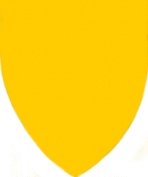
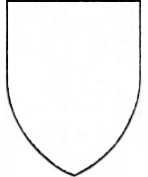
Simplicity of design is no longer as straightforward as it was in the Middle Ages, as there are now so many devices that more and more clever means need to be found to meet the requirements of uniqueness.
But simplicity of colour is still a cornerstone of armorial composition.
There are three basic types of colouring: metals, tinctures (or ordinary colours) and furs.
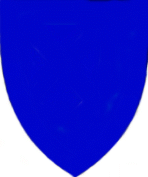
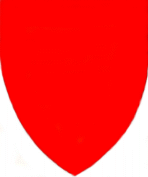
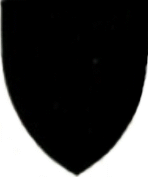
Coats of arms comprising a single colour alone are rare, but since it is invariably better to give examples of actual coat-armour, the illustrations here and on the pages for metals, tinctures and furs are, as far as possible, taken from the devices of real armigers – even if, in many cases, they are no longer borne as simple coats of arms, but appear as quarterings in the arms of aristocratic families with long lineages.
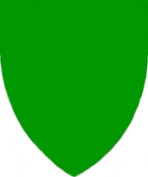
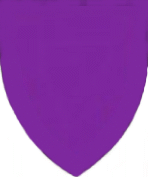
The arms shown here are those of De Menezes (a gold shield), Zgraia (silver), Gournay (black), d’Albret (red), Maienthal (blue), Pupellin (green), Aubert (purple), the Dukes of Brittany (ermine), De Rousselet (ermines), Van der Eze (erminois) and Zu Pappenheim (vair).
Each of these three categories of colour/tincture is dealt with on its own page. The additional colours, most of which can be put into the fourth class of stains, are mentioned here under tinctures.



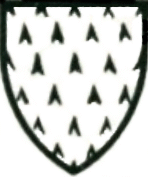
However, the meaning of the word tincture is itself a subject of considerable disagreement. To some authorities on heraldry, it means the ordinary colours only – (blue [azure], red [gules], black [sable], green [vert] and purple [purpure] – while to others it covers all the colourings.
Franklyn and Tanner[1] state unequivocally:
“tincture: [M.E. fm L.] colour (exclusive of metal (q.v.)), to the employment of which heraldic art is restricted: there are five only in general use: gules (q.v.), sable (q.v.), vert (q.v.), azure (q.v.) and purpure (q.v.).”
And Fox-Davies[2] puts it even more precisely:
“The metals are gold and silver, these being termed ‘or’ and ‘argent’. The colours, which are really the ‘tinctures’, if this word is to be used correctly, are: gules (red), azure (blue), vert (green) purpure (purple), and (in spite of the fact that it is not really a colour) black, which is known as sable.” [My emphasis.]
On the other hand, Boutell[3] puts it exactly the other way round:
“The tinctures of heraldry comprise two metals, seven colours, and various furs.”
Brooke-Little, who revised both authors’ work, has no footnote in either passage, effectively contradicting himself!
And Moncreiffe and Pottinger[4] have the heading “TINCTURES” at the top of their page dealing with (respectively) the five “colours”, the two metals and four furs (there are other furs, but since their title is Simple Heraldry, they don’t go into too much detail).
The dictionaries seem generally to use “tincture” to mean all of these (usual) groups of heraldic colourings.
Other colours sneak in from time to time under the fifth classification, called proper, which means “in its natural colours” – any natural object can be blazoned as being proper, which allows the artist to use the natural colouring, whether or not it is conventionally regarded as a heraldic colour.
In a few cases, “proper” can also mean colours that have traditionally been assigned to creatures that in scientific fact bear no resemblance to the mediæval heraldic depiction of them, or which do not really exist in the natural world.
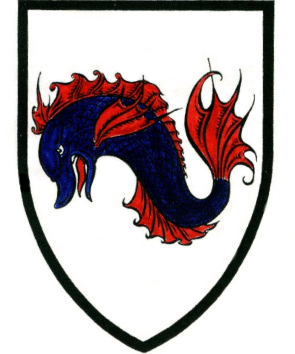
A typical example is the dolphin, which was thought to be a fish, and is shown with scales, usually in green and red. This illustration (of the arms of Moneypenny, of Kent) shows the “fish” as blue, but the red fins can be clearly seen.
See here for a further discussion of “proper”.
The basic principle of heraldic colouring is the rule of tincture, sometimes called the law of heraldic colours.
It is for the most part merely a practical rule of thumb. Boutell writes:
“As a general rule of heraldry, a metal object may not be laid upon a metal field, nor a coloured one upon colour. This originated in the utilitarian purpose of heraldry to distinguish warriors in the field and lists, where arms of contrasting tinctures would be more clearly visible than (say) gold charges on silver, or blue on green.
“To this rule there are exceptions. Where a field is varied of a metal and a colour, a charge of either metal or colour may be laid on it, provided it rests on the field as a whole, and not only on one of the tinctures of the field.”
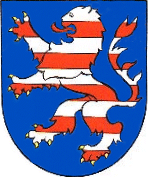
He does not mention the barry (stripy) lion of Hessen, which is the reverse of this – a metal-and-colour combination on a field of a different colour. Returning to Boutell:
“The rule is likewise relaxed in the case of bordures and chiefs, and of a charge surmounting both the field and another charge. The rule does not apply to furs, or to charges blazoned as proper.”
The question as to whether the rule applies to furs is discussed further under that heading, while actual examples of tincture on tincture are discussed here, and the famous example of metal on metal here.
Boutell also mentions the 16th-century craze for inventing fancy sets of names for the colours used in the arms of various degrees of society.
The followers of this cult insisted that the arms of sovereigns should be colour-named for heavenly bodies – Sol for gold, Saturn for black – while the arms of nobles should use the names of precious stones.
Many books of reference give these terms, but they were in fact rarely used and are included solely for the purpose of identifying the actual colours of the arms in question. There is no sound reason whatever for using such names.
It has often been argued since early in the 20th century (and probably before) that there is no longer any need for the use of special names for colours, and that the traditional heraldic colour-names of or (gold), argent (silver), gules (red), azure (blue), and so on, should be abandoned in favour of plain English words – or words in whatever language is being used to blazon or describe a coat of arms.
The argument has been won in Afrikaans, which does in fact use ordinary colour-names, but it has its drawbacks.
The chief downfall of such nomenclature lies in the fact that the metals of heraldry should in most cases not be illustrated as being metallic, for reasons of both cost and practicality. (This is discussed in the article on metals.)
The furs of heraldry are an additional reason to avoid common colour-names, since the traditional armorial furs are abstractions and stylisations.
Ermine means white with black stylised tails, not the actual fur of a stoat-like animal that turns white when the winter snow falls. Vair means stylised blue and white alternating patches, not actual squirrel fur in alternating dark and light grey.
And vairy can be a vair-like pattern in any combination of metal and tincture.
The final complication of heraldic colours is the system of hatching.
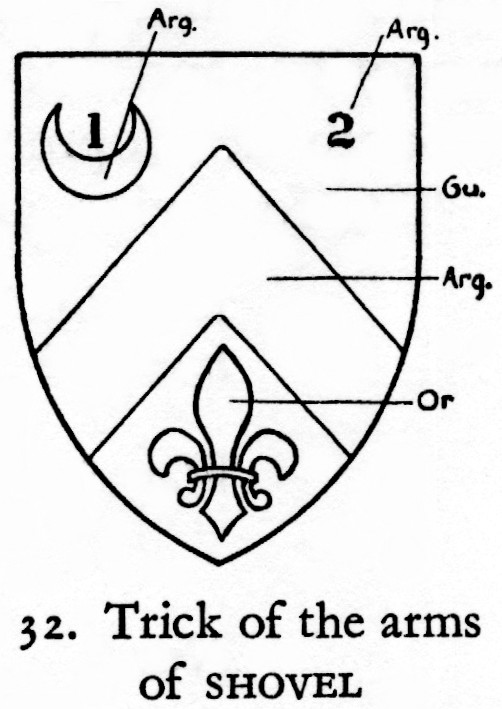
It was not found in mediæval heraldry – rolls of arms from that period, when completed (as opposed to being done in “trick” form, a sort of herald’s shorthand in drawing format) are invariably in colour.
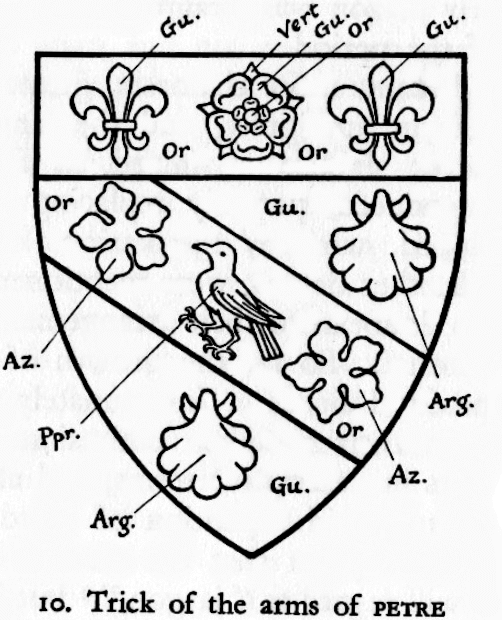
Shown here are two examples of tricking. Aside from being in rough draft form – visual notes made by the herald for the guidance of the herald painter – they also make use of a set of abbreviations for the colours/tinctures.
These are occasionally encountered in books and other references on heraldry, and although they actually make blazon more difficult for the layman to read, it is helpful to have a key. The generally used abbreviations used in tricking are, in alphabetical order:
A or Ar = argent; B = azure (Az might be confused with Ar); G = gules; Purp = purpure; S or Sa = sable; V or Vt = vert.
Other (longer) abbreviations are also used in some books, but again they are mainly confusing to the general reader.
Hatching came into use through copper-plate engraving and was widely adopted for engraving in silverware, as well as for illustrations in books where the use of colour printing was prohibitive.
Its widespread use actually detracts from heraldry, since it removes the essential colour that gives coat-armour its immediacy and brilliance, but it is often useful to have a key to it, to allow the identification of a device illustrated in this way.
